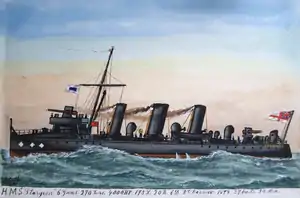HMS Sturgeon (1894)
HMS Sturgeon was the lead ship of the Sturgeon-class destroyers which served with the Royal Navy. Built by Vickers, she was launched in 1894 and sold in 1910.
 A watercolour of Sturgeon c. 1901 | |
| History | |
|---|---|
| Name: | HMS Sturgeon |
| Builder: | Vickers |
| Launched: | 1894 |
| Fate: | Sold, 1910 |
| General characteristics | |
| Class and type: | Sturgeon-class destroyer |
| Propulsion: | Blechynden boilers, 4,000 hp (2,983 kW) |
| Speed: | 27 knots (50 km/h; 31 mph) |
| Complement: | 53 |
| Armament: |
|
Construction and design
On 8 November 1893, the British Admiralty placed an order with the Naval Construction and Armament Company of Barrow-in-Furness (later to become part of Vickers) for three "Twenty-Seven Knotter" destroyers as part of the 1893–1894 construction programme for the Royal Navy,[1] with in total, 36 destroyers being ordered from various shipbuilders for this programme.[2]
The Admiralty only laid down a series of broad requirements for the destroyers, leaving detailed design to the ships' builders. The requirements included a trial speed of 27 knots (31 mph; 50 km/h), a "turtleback" forecastle and a standard armament of a QF 12 pounder 12 cwt (3 in (76 mm) calibre) gun on a platform on the ship's conning tower (in practice the platform was also used as the ship's bridge), with a secondary armament of five 6-pounder guns, and two 18 inch (450 mm) torpedo tubes.[3][4][5]
The Naval Construction and Armament Company produced a design with a length of 194 feet 6 inches (59.28 m) overall and 190 feet (57.91 m) between perpendiculars, with a beam of 19 feet (5.79 m) and a draught of 7 feet 7 inches (2.31 m). Displacement was 300 long tons (300 t) light and 340 long tons (350 t) deep load.[1] Three funnels were fitted, with the foremast between the ship's bridge and the first funnel.[6][7] Four Blechyndnen water-tube boilers fed steam at 200 pounds per square inch (1,400 kPa) to two three-cylinder triple expansion steam engines rated at 4,000 indicated horsepower (3,000 kW).[1][8] A speed of 27.6 knots (51.1 km/h; 31.8 mph) was reached during sea trials.[9] 60 tons of coal were carried,[10] giving a range of 1,370 nautical miles (2,540 km; 1,580 mi) at a speed of 11 knots (20 km/h; 13 mph).[11] The ship's crew was 53 officers and men.[11]
Service
Sturgeon served in home waters for the whole of her career.[1] She took part in the fleet review held at Spithead on 26 June 1897 to celebrate the Diamond Jubilee of Queen Victoria.[12] From 1899 she served in the Medway Instructional Flotilla under Commander Murray MacGregor Lockhart, but in March 1900 she was replaced by HMS Cynthia to which Commander Lockhart also transferred.[13] She left this for other service in late 1900. The following year she again took up with the Medway instructional flotilla, replacing Mallard.[14] She had a refit in early 1902.[15] In May 1902 she received the officers and men from the destroyer Stag, and was again commissioned at Chatham on 8 May by Lieutenant John Maxwell D. E. Warren for service with the Flotilla.[16][17] She took part in the Spithead fleet review held on 16 August 1902 for the coronation of King Edward VII,[18] and later the same month was placed in dockyard hands at Sheerness for her boiler to be re-tubed.[19]
Notes
- Lyon 2001, p. 69.
- Lyon 2001, p. 19.
- Lyon 2001, p. 20.
- Lyon 2001, pp. 98–99.
- Friedman 2009, p. 40.
- Friedman 2009, p. 50.
- Manning 1961, p. 38.
- The Engineer 11 October 1895, p. 365.
- "The Naval Construction and Armaments Co., Barrow-in-Furness: Visit of the Manchester Association of Engineers". The Marine Engineer and Naval Architect. Vol. 17. August 1895. pp. 186–187.
- Brassey 1902, p. 274.
- Friedman 2009, p. 291.
- Brassey 1898, pp. 12–13
- "Naval & Military intelligence". The Times (36085). London. 9 March 1900. p. 12.
- "Naval & Military intelligence". The Times (36581). London. 9 October 1901. p. 8.
- "Naval & Military intelligence". The Times (36773). London. 21 May 1902. p. 10.
- "Naval & Military intelligence". The Times (36761). London. 7 May 1902. p. 10.
- "Naval & Military intelligence". The Times (36768). London. 15 May 1902. p. 7.
- "Naval Review at Spithead". The Times (36847). London. 15 August 1902. p. 5.
- "Naval & Military intelligence". The Times (36855). London. 25 August 1902. p. 8.
References
- Brassey, T.A. (1898). The Naval Annual 1898. Portsmouth, UK: J. Griffin and Co.
- Brassey, T.A. (1902). The Naval Annual 1902. Portsmouth, UK: J. Griffin and Co.
- Chesneau, Roger & Kolesnik, Eugene M., eds. (1979). Conway's All The World's Fighting Ships 1860–1905. London: Conway Maritime Press. ISBN 0-85177-133-5.
- Colledge, J. J.; Warlow, Ben (2006) [1969]. Ships of the Royal Navy: The Complete Record of all Fighting Ships of the Royal Navy (Rev. ed.). London: Chatham Publishing. ISBN 978-1-86176-281-8.
- Friedman, Norman (2009). British Destroyers: From Earliest Days to the Second World War. Barnsley, UK: Seaforth Publishing. ISBN 978-1-84832-049-9.
- Gardiner, Robert & Gray, Randal, eds. (1985). Conway's All The World's Fighting Ships 1906–1921. London: Conway Maritime Press. ISBN 0-85177-245-5.
- Layman, R. D. (1994). "Naval Kite Trials". In Roberts, John (ed.). Warship 1994. London: Conway Maritime Press. pp. 35–51. ISBN 0-85177-630-2.
- Lyon, David (2001) [1996]. The First Destroyers. London: Caxton Editions. ISBN 1-84067-3648.
- Manning, Captain T. D. (1961). The British Destroyer. Putnam and Co. OCLC 6470051.
- "Speed Trials of the Torpedo Boat Destroyer Starfish" (PDF). The Engineer. Vol. 80. 11 October 1895. p. 365.